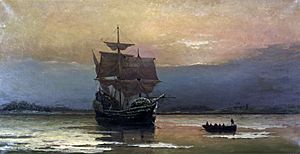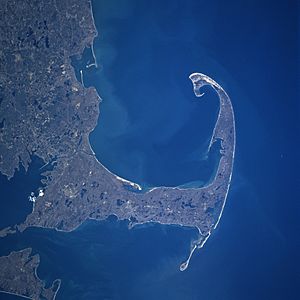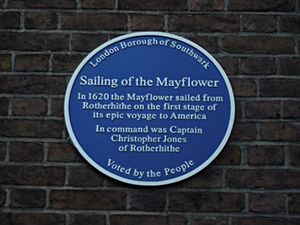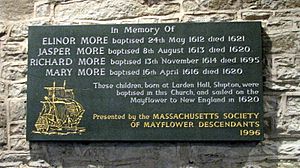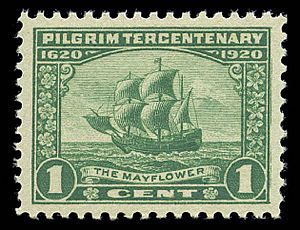Mayflower facts for kids
|
Mayflower in Plymouth Harbor by William Halsall (1882)
|
|
| Name | Mayflower |
| Namesake | Crataegus monogyna (may) |
| Owner | Christopher Jones (¼ of the ship) |
| Maiden voyage | Before 1609 |
| Out of service | 1622–1624 |
| Fate | most likely taken apart by Rotherhithe shipbreaker c. 1624. |
Quick facts for kids General characteristics |
|
|---|---|
| Class and type | Dutch cargo fluyt |
| Tonnage | 180 tons + |
| Length | c. 80–90 ft (24–27.5 m) on deck, 100–110 ft (30–33.5 m) overall. |
| Decks | Around 4 |
| Capacity | Unknown, but carried c. 135 people to Plymouth Colony |
The Mayflower was the famous ship that transported the Pilgrims from Plymouth, England, to Plymouth Colony, Massachusetts (United States), in 1620.
The vessel left England on September 6, and after a gruelling journey marked by disease, the ship dropped anchor inside the hook tip of Cape Cod (Provincetown Harbor) on November 11 (dates in Old Style, Julian Calendar). The Mayflower originally was destined for the Hudson River, north of the 1607 Jamestown Settlement.
However, the Mayflower went severely off-course as the winter approached and remained in Cape Cod Bay (mapped in 1602 by Gosnold).
On March 21, 1621, all surviving passengers, who had inhabited the ship during the winter, moved ashore as Plymouth Colony, and on April 5, the Mayflower, a privately commissioned vessel, returned to England (details below).
In 1623, a year after the death of captain Christopher Jones, the Mayflower was dismantled for scrap lumber in Rotherhithe, London, England.
Contents
Ship
The Mayflower was used primarily as a cargo ship, involved in active trade of goods (often wine) between England and other European countries,
(principally France, but also Norway, Germany, and Spain). At least between 1609 and 1622, it was mastered by Christopher Jones, who would command the ship on the famous transatlantic voyage, and based in Rotherhithe, London, England. After the famous voyage of the Mayflower, the ship returned to England, likely dismantled for scrap lumber in Rotherhithe in 1623, only a year after Jones's death in March 1622. The Mayflower Barn, just outside the Quaker village of Jordans, in Buckinghamshire, England, is said to be built from these timbers.
Details of the ship's dimensions are unknown; but estimates based on its load weight and the typical size of 180-ton merchant ships of its day suggest an estimated length of 90–110 feet (27.4–33.5 m) and a width of about 25 feet (7.6 m). The ship was manned by a crew of 25-30.
Replica
Careful research went into designing a replica, the Mayflower II (launched September 22, 1956), to resemble its namesake in every detail. This vessel is now part of the Plimoth Plantation living museum, near Plymouth, Massachusetts.
Pilgrims' voyage

Initially, the plan was for the voyage to be made in two vessels, the other being the smaller Speedwell. The first voyage of the ships departed Southampton, England,
on August 5, 1620; but the Speedwell developed a leak, and had to be refitted at Dartmouth.
On the second attempt, the ships reached the Atlantic Ocean but again were forced to return to Plymouth because of the Speedwell's leak.
It would later be revealed that there was in fact nothing wrong with the Speedwell. The crew had sabotaged it in order to escape the year long commitment of their contract.
After reorganisation, the final sixty-six day voyage was made by the Mayflower alone, leaving Plymouth, England on September 6. With 102 passengers plus crew, each family was allotted a very confined amount of space for personal belongings.
The ship probably had a crew of twenty-five to thirty, along with other hired personnel; however, only the names of five are known, including John Alden. William Bradford, who penned our only account of the Mayflower voyage, wrote that John Alden (archaic spellings) "was hired for a cooper [barrel-maker], at South-Hampton, where the ship victuled; and being a hopefull yong man, was much desired, but left to his owne liking to go or stay when he came here; but he stayed, and maryed here."
The intended destination was an area near the Hudson River, in "North Virginia". However the ship was forced far off-course by inclement weather and drifted well north of the intended Virginia settlement. As a result of the delay, the settlers did not arrive in Cape Cod till the onset of a harsh New England winter. The settlers ultimately failed to reach Virginia where they had already obtained permission from the London Company to settle.
To establish legal order and to quell increasing strife within the ranks, the settlers wrote and signed the Mayflower Compact after the ship dropped anchor at the tip of Cape Cod on November 11, in what is now Provincetown Harbor.
The settlers, upon initially setting anchor, explored the snow-covered area and discovered an empty Native American village. The curious settlers dug up some artificially-made mounds, some of which had stored corn while others were burial sites. The settlers stole the corn sparking friction with the locals. They explored the area of Cape Cod for several weeks and decided to relocate after a difficult encounter with the local native Americans, the Nausets.
During the winter the passengers remained on board the 'Mayflower', suffering an outbreak of a contagious disease described as a mixture of scurvy, pneumonia and tuberculosis. When it ended, there were only 53 persons still alive, half of the passengers and half of the crew. In spring, they built huts ashore, and on March 21, 1621, the surviving passengers left the 'Mayflower'.
On April 5, 1621, the Mayflower set sail from Plymouth Colony to return to England, where she arrived on May 6, 1621.
Passengers
The 102 passengers on the Mayflower were the earliest permanent European settlers in New England (remember that the Jamestown settlers were the first permanent English settlement in what would become the United States); some of their descendants have taken great interest in tracing their ancestry back to one or more of these Pilgrims. (See The Society of Mayflower Descendants, "List of passengers on the Mayflower" for a complete accounting. See also "List of Mayflower passengers who died in the winter of 1620–1621".) Throughout the winter, the passengers spent time ashore preparing homesites and searching for food but partly remained based aboard the Mayflower. Only about half of the settlers would still be alive when the Mayflower left in the spring. Governor Bradford noted that about half the sailors died as well.
Second Mayflower
In 1629, a ship called the Mayflower made a voyage from London to Plymouth Colony carrying thirty-five passengers, many from Leiden. This was not the same ship that made the original voyage with the first settlers. This voyage began in May and reached Plymouth in August.
Popular culture
The Mayflower voyage and the ship became famous as an icon of a perilous one-way trip to a new life, with many things named for it:
- The Mayflower is the emblem of the English football club Plymouth Argyle F.C., who are known as "The Pilgrims" (nickname).
- Songwriter Paul Simon mentions the ship in his "American Tune" (song).
- Folk/Rock singer Bob Dylan mentions the ship in his song "Bob Dylan's 115th Dream" on the album Bringing It All Back Home.
- The space-shuttle parody in the movie Airplane II: The Sequel is called Mayflower One.
Many Americans believe themselves to be descended from Mayflower passengers, e.g. that somebody's ancestors go "all the way back to the Mayflower".
While the Mayflower brought one early settlement, it can be compared to other settlements in North America:
- The Mayflower sailed in 1620, but Virginia was settled in 1607 at Jamestown, 1610 at Hampton, 1611 at Henricus, 1613 at Newport News, 1613 at New Bermuda, and several other Virginia settlements which pre-date Plymouth. Virginia even had black indentured servants by 1619 and a population of about 4,500 in 1623. Also, Albany, New York, was settled by the Dutch in 1614, Santa Fe, New Mexico by the Spanish in 1610, and St. Augustine, Florida dates back to the 16th century.
- Considering Puerto Rico, the towns of Caparra and Old San Juan would be the first European settlement in the USA, in 1508.
- Centuries earlier, 500 years before the voyage of Christopher Columbus, the Vikings, from Scandinavia, had established a permanent settlement in Greenland (see: Western Settlement (Greenland)) from 1000 A.D. until circa 1500 A.D. That settlement lasted 500 years, almost 100 years older than the entire colonial history of the United States.
However, with the Mayflower voyage in 1620, more emphasis is placed on the so-called "First Thanksgiving" and the peaceful co-existence with the native Wampanoag tribe, as issues of civilized culture, among the 13 original colonies of the U.S.
Related pages
Images for kids
-
Pilgrims John Carver, William Bradford and Miles Standish at prayer during their voyage to North America. 1844 painting by Robert Walter Weir.
-
Mayflower II, a replica of the original Mayflower, docked at Plymouth, Massachusetts
See also
 In Spanish: Mayflower para niños
In Spanish: Mayflower para niños


